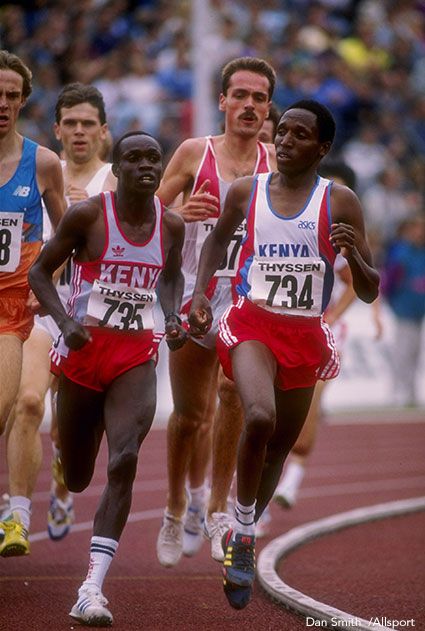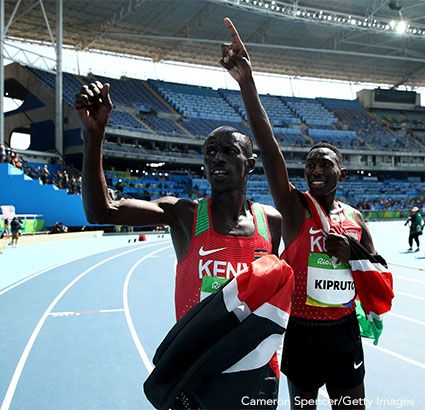The term "Kenyan runner" brings to mind a picture of barefoot athletes traipsing through mist-shrouded forests in a land that is literally halfway around the world. But the rise of running in Kenya has been anything but a walk through the woods.
In 1976, an Irish-Catholic teacher, Brother Colm O'Connell, first set foot in Iten, a small town in the Great Rift Valley. Brother Colm went to Iten to teach geography at St. Patrick's High School. Then fate stepped in.
"He stumbled on a ton of talent," said Weldon Kennedy, an American entrepreneur in Kenya. "And then Kenya was invited to the world junior championships and decided to send the best track team from the best high school. (St. Patrick's) absolutely dominated and it didn't take much time for running to take off."
There is a little more to the story – when Brother Colm arrived in Iten, now known as a running hotbed, another teacher from the United Kingdom, Pete Foster, was the school's track coach. But Foster knew he'd be leaving sooner than later, so he convinced Brother Colm – who knew nothing about running – to take over the program.

About a decade later, Kenya truly broke on to the international running scene when Peter Rono upset Sebastian Coe in the 1,500 meters at the 1988 Seoul Olympics. Rono was one of four Kenyan track-and-field gold medalists at Seoul, where Kenya won a total of seven running medals.
Rono was Brother Colm's first Olympic champion. His most recent was David Rudisha, who won the Olympic gold meters in the 800 meters in 2012 and 2016. Rudisha is among the 48 track-and-field athletes representing Kenya in Rio. Conseslus Kipruto won the gold in the 3,000 steeplechase. Vivian Jepkemoi Cheruiyot, the silver medalist in the women's 10,000, hails from Keiyo in the Rift Valley Province where Iten is also located.
There have been plenty of international successes since Brother Colm took over St. Patrick's running program, yet he's never seen any of his protégés win their biggest races in person.
For Brother Colm, it's not the wins that motivate, rather it is the evolution of his athletes and students.
"I've always concentrated on the development of young athletes," Brother Colm told The Independent in 2012. "That's where the Kenyan supply line comes from. I've not really moved up the line and ignored the youngsters."
Brother Colm's efforts have now spanned more than three decades, and while he is certainly responsible for putting Kenyan runners on the map, there are other factors that have played into the country's long-term success.
Kenya's Great Rift Valley is an enormous and sparsely developed mountain region with active volcanoes, lush forests, temperate weather and plenty of elevation change. Iten is considered the epicenter of distance running in Kenya, but the sport now permeates the entire region.

"Iten is kind of a mythical place in Kenya and you think of mystical clouds and wizards, but it's just this quaint little town," said Kennedy, whose company is making Kenya's first running shoes. "But it's home to world-class runners. It's fun to tell the story of a town of 40,000 people that has so many world-class athletes. You sit down to have dinner and the fastest marathoner from x-y-z is right there."
Over time, Iten has evolved into more of a track town while nearby Kaptagat is a hub for long-distance runners and marathoners, including Elijah Lagat (2000 Boston Marathon winner), Moses Tanui (10,000 world champion in 1991) and Brimin Kipruto (3,000m steeplechase Olympic gold medal in 2008). While the subtle distinction is relevant to runners, to the layperson the entire region seems to be overflowing with talent.
While the topography and climate make for the perfect training grounds, it is the work ethic that can be traced back to Brother Colm that has continued to transform runners into champions.
"There is no trick," said Kennedy, a casual runner himself. "It is training hard and eating right. The best runners in the world have been on their feet since they were little kids, so they're in better physical health. And they run hard, six days a week."
Kenyan Olympic Gold Medalists In Running, 1988-2016
Seoul, 1988
Julius Kariuki, 3,000 steeplechase
John Ngugi, 5,000
Paul Ereng, 800
Peter Rono, 1,500
Barcelona, 1992
Matthew Birir, 3,000
William Tanui, 800
Atlanta, 1996
Joseph Keter, 3,000 steeplechase
Sydney, 2000
Noah Ngeny, 1,500
Reuben Kosgei, 3,000 steeplechase
Athens, 2004
Ezekiel Kemboi, 3,000 steeplechase
Beijing, 2008
Asbel Kipruto Kiprop, 1,500
Brimin Kiprop Kipruto, 3,000 steeplechase
Wilfred Bungei, 800
Samuel Wanjiru, marathon
Pamela Jelimo, 800
Nancy Lagat, 1,500
London, 2012
Ezekiel Kemboi, 3,000 steeplechase
David Rudisha, 800
Rio, 2016
Jemima Jelagat Sumgong, marathon
David Rudisha, 800
Faith Chepngetich Kipyegon, 1,500
Conseslus Kipruto, 3,000 steeplechase
More Olympics:
-- Michael Phelps Teaches Katie Ledecky Proper Medal-Wearing Technique
-- Olympians In The NFL
-- Diving At Finish Line Isn't Just Legal, It's Smart




